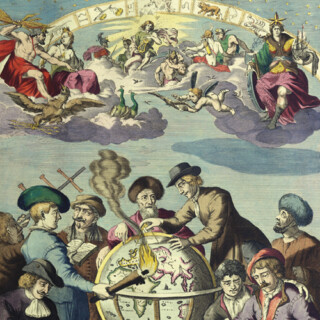First edition of this translation by Ogilby illustrated with more than seventy engravings by Hollar
Opera per Johannem Ogilvium edita et sculpturis aenis adoranata.
London,
Thomas Roycroft,
1654-1658.
First edition. Two volumes, folio (409 by 258mm). Title printed in red and black, (vol. one) 2ff. 447 pp., portrait frontispiece of Ogilby by W. Faithorne after Lely, additional frontispiece by P. Lombart after F. Cleyn (trimmed), 94 full-page engravings after F. Cleyn with coats of arms inscribed underneath each of them, of which 33 by Hollar, folding map titled "Aenae troiani navigation" by Hollar, 12 engraved initials and headpieces, 4 plates cut down and mounted; (vol. two) 7 ff., 586 pp. portrait frontispiece of Ogilby by W. Faithorne after Lely (trimmed), additional frontispiece by P. Lombart & Richer after F. Cleyn, 98 full-page engravings with coats of arms inscribed underneath each of them, after F. Cleyn, of which 39 by Hollar, folding map titled "Aenae troiani navigation" by Hollar mounted on tab, 22 engraved initials and headpieces. Late eighteenth or early nineteenth century Russian calf, borders formed by a roll in blind, with gilt fillets, gilt tooled and paneled backs, corners and hinges slightly rubbed, title and author inscribed in gold on a green morocco lettering piece, with all edges in gilt.
18629
notes:
John Ogilby (1600-1676) was one of the most interesting British mapmakers, and translator of Homer and Virgil. After a slightly disreputable start in life, Ogilby gained a certain notoriety in 1637 when he opened the first theatre of Ireland in Dublin. Here he mingled dance and drama with fluency, but was beset with financial difficulties and the institution had to close in 1641. In 1650, he published his first important work The fables of Aesop paraphras'd in verse, illus...
bibliography:
NHG Hollar 1344, 1351, 1353, 1355-1395; Pennington 290-332; Lowndes, V, p. 2776; Brunet V p. 1289.
provenance:
Provenance:
Sir Edward Henry Scott (1840-1880) 4th Baronet of Lytchett Minster, bibliophile (bookplate).
Sir Edward Henry Scott (1840-1880) 4th Baronet of Lytchett Minster, bibliophile (bookplate).










